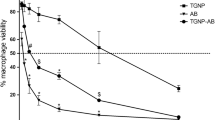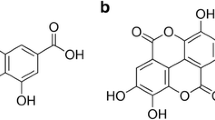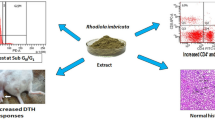Abstract
This work investigated the use of water extract of green propolis (WEP) and its association with free or liposomal meglumine antimoniate (MA) for the treatment of murine visceral leishmaniasis. Mice infected with Leishmania infantum were treated with oral doses of WEP associated or not with a single dose of liposomal MA by intraperitoneal route. Parasite burden was assessed in the liver and spleen by limiting dilution assay, and alterations in the spleen cellular phenotype were evaluated by flow cytometry. Tissue damage was assessed by determination of biochemical markers of the liver, heart, and kidney function and histopathological analysis of the liver and spleen. Our data showed that treatment with WEP was able to reduce parasite load in the liver but not in the spleen. On the other hand, liposomal MA reduced parasite load in both organs. Unexpectedly, there was no synergism with the combination of WEP and liposomal MA in reducing the parasite load. The histopathological analysis showed that administration of WEP, liposomal MA, or their association was able to protect the liver and spleen from lesions caused by infection. No alteration in the profile of spleen cells by flow cytometry or in the liver, heart, and kidney functions by biochemical markers due to any of the treatments was observed. These results demonstrate that although WEP was able to significantly reduce the liver parasite load, its association with liposomal MA did not lead to significant improvement in reducing parasite load. On the other hand, treatment with WEP and/or liposomal MA protected the liver and spleen from lesions caused by the infection.





Similar content being viewed by others

References
Ayres DC, Marcucci MC, Giorgio S (2007) Effects of Brazilian propolis on Leishmania amazonensis. Mem Inst Oswaldo Cruz 102(2):215–220
Batista CM, Carvalho CMB, Magalhaes NSS (2007) Lipossomas e suas aplicações terapêuticas: estado da arte. Rev Bras Cienc Farm, São Paulo, 43(2)
Black CD, Watson GJ, Ward RJ (1977) The use of Pentostam liposomes in the chemotherapy of experimental leishmaniasis. Trans R Soc Trop Med Hyg 71(6):550–552
Capelari-Oliveira P, Paula CA, Rezende SA, Campos FT, Grabe-Guimarães A, Lombardi JA, Saúde-Guimarães DA (2011). Anti-inflammatory activity of Lychnophora passerina, Asteraceae (Brazilian Arnica). Ethnopharmacol 17;135(2): 393–398
Da Silva Filho AA, Resende DO, Fukui MJ, Santos FF, Pauletti PM, Cunha WR, Silva ML, Gregório LE, Bastos JK, Nanayakkara NP (2009) In vitro antileishmanial, antiplasmodial and cytotoxic activities of phenolics and triterpenoids from Baccharis dracunculifolia D. C. (Asteraceae). Fitoterapia 80(8):478–482. doi:10.1016/j.fitote.2009.06.007
Da Silva SS, Thomé GS, Cataneo AHD, Miranda MM, Felipe I, Andrade CG, Watanabe MA, Piana GM, Sforcin JM, Pavanelli WR, Conchon-Costa I (2013) Brazilian propolis antileishmanial and immunomodulatory effects. Evid Based Complement Alternat Med 2013:673058. doi:10.1155/2013/673058
De Castro SL (2001) Propolis: biological and pharmacological activities. Therapeutic uses of this bee-product. Ann Rev Biomed Sci 3:49–83
Demicheli C, Ochoa R, Lula IS, Gozzo FC, Eberlin M, Frezard F (2003) Pentavalent organoantimonial derivatives: two simple and efficient synthetic methods for meglumine antimoniate. Appl Organomet Chem 17:226–231
Demicheli C, Rocha OGF, Frezard F (2004) Lipossomas: Propriedades físico-químicas e farmacológicas, aplicações na quimioterapia à base de antimônio. Química Nova XY( 00), 1-x
Duran N, Muz M, Culha G, Duran G, Ozer B (2011) GC-MS analysis and antileishmanial activities of two Turkish propolis types. Parasitol Res 108:95–105
Ferreira CS, Martins PS, Demicheli C, Brochu C, Ouellette M, Frézard F (2003) Thiol-induced reduction of antimony (V) into antimony (III): a comparative study with trypanothione, cysteinylglycine, cysteine and glutathione. BioMetals 16:441–443
Frezard F, Demicheli C (2010) New delivery strategies for the old pentavalent antimonial drugs. Expert Opin Drug Deliv 7(12):1343–1358
Frezard F, Schettini DA, Rocha OGF, Demicheli C (2005) Liposomes: physicochemical and pharmacological properties, applications in antimony-based chemotherapy. Quim Nova 28:511–518
Frezard F, Demicheli C, Ribeiro RR (2009) Pentavalent antimonials: new perspectives for old drugs. Molecules 14:2317–2336
Han S, Sung KH, Yim D, Lee S, Cho K, Lee CK, Ha NJ, Kim K (2002) Activation of murine macrophage cell line RAW 264.7 by Korean propolis. Arch Pharm Res 25:895–902
Jasprica I, Mornar A, Debeljak Z, Smolcic-Bubalo A, Medic-Saric M, Mayer L, Romic Z, Bucan K, Balog T, Sobocanec S, Sverko V (2007) In vivo study of propolis supplementation effects on antioxidative status and red blood cells. J Ethnopharmacol 110:548–554
Jha TK (2006) Drug unresponsiveness & combination therapy for kalazar. Indian J Med Res 123:389–398
Kaneeda J, Nishina T (1994) Safety of propolis. Acute toxicity. Honeybee Sci 15:29–33
Kucharzewski M, Kubacka S, Urbanek T, Wilemska-Kucharzewska K, Morawiec T (2013) Stan Scheller: the forerunner of clinical studies on using propolis for poor and chronic nonhealing wounds. Evid Based Complement Alternat Med 2013:1–5
Limongi JP, Corbett CE (1973) Em Farmacodinâmica ed.; Livraria Editora Artes Médicas: São Paulo 61
Machado GMC, Leon LL, De Castro SL (2007) Activity of Brazilian and Bulgarian propolis against different species of Leishmania. Mem Inst Oswaldo Cruz 102(1):73–77
Mani F, Damasceno HCR, Novelli ELB, Martins EAM, Sforcin JM (2006) Propolis: effect of different concentrations, extracts and intake period on seric biochemical variables. J Ethnopharmacol 105:95–98
Marcucci MC (1996) Propriedades biológicas e terapêuticas dos constituintes químicos da própolis. Quim Nova 19:529–535
Marques-da-Silva EA, Coelho EA, Gomes DC, Vilela MC, Masioli CZ, Tavares CA, Fernandes AP, Afonso LC, Rezende SA (2005) Intramuscular immunization with p36(LACK) DNA vaccine induces IFN-gamma production but does not protect BALB/c mice against Leishmania chagasi intravenous challenge. Parasitol Res 98:67–74
McElrath MJ, Murray HW, Cohn ZA (1988) The dynamics of granuloma formation in experimental visceral leishmaniasis. J Exp Med 167:1927–1937
Mosmann T (1983) Rapid colorimetric assay for cellular growth and survival: application to proliferation and cytotoxicity assays. J Immunol Methods 65:55–63
Moura SAL, Ferreira MAND, Andrade SP, Reis MLC, Noviello ML, Cara DC (2011) Brazilian green propolis inhibits inflammatory angiogenesis in a murine sponge model. Evid Based Complement Alternat Med 2011:1–7
Oršolić N, Benković V, Lisičić D, Dikić D, Erhardt J, Knežević AH (2010) Protective effects of propolis and related polyphenolic/flavonoid compounds against toxicity induced by irinotecan. Med Oncol 27(4):1346–1358
Pontin K, Silva Filho AA, Santos FF, Silva MLA, Cunha WR, Nanayakkara NPD, Bastos JK, Albuquerque S (2008) In vitro and in vivo antileishmanial activities of a Brazilian green propolis extract. Parasitol Res 103:487–492
Rao LS, Hardy JG, Wilson CG (1983) Tissue distribution and fate of free and liposome-encapsulated [125Sb] sodium stibogluconate by gamma scintigraphy. Int J Pharm 17:283–290
Rath S, Trivelin LA, Imbrunito TR, Tomzela DM, Jesúz MN, Marzal PC (2003) Antimoniais empregados no tratamento da leishmaniose: estado da arte. Quim Nova 26:4
Ribeiro RR, Moura EP, Pimentel VM, Sampaio WM, Silva SM, Schettini DA, Alves CF, Melo FA, Tafuri WL, Demicheli C, Melo MN, Frézard F, Michalick MS (2008) Reduced tissue parasitic load and infectivity to sand flies in dogs naturally infected by Leishmania (Leishmania) chagasi following treatment with a liposome formulation of meglumine antimoniate. Antimicrob Agents Chemother 52(7):2564–2572
Schettini DA, Ribeiro RR, Demicheli C, Rocha OG, Melo MN, Michalick MS, Frézard F (2006) Improved targeting of antimony to the bone marrow of dogs using liposomes of reduced size. Int J Pharm 315(1–2):140–147
Sforcin JM (2007) Propolis and the immune system: a review. J Ethnopharmacol 113:1–14
Sforcin JM, Kaneno R, Funari SRC (2002) Absence of seasonal effect on the immunomodulatory action of Brazilian propolis on natural killer activity. J Venom Anim Toxins 8:19–29
Sieuwerts AM, Klijin JGM, Peters HA, Foekens JA (1995) The MTT tetrazolium salt assay scrutinized: how to use this assay reliably to measure metabolic activity to cell culture in vitro for the assessment of growth characteristics, IC50-values and cell survival. Eur J Clin Chem Clin Biochem 33:813–823
Smelt SC, Engwerda CR, Mccrossen M, Kaye PM (1997) Destruction of follicular dendritic cells during chronic visceral leishmaniasis. J Immunol 158:3813–3821
Solbach W, Laskay T (2000) The host response to Leishmania infection. Adv Immunol 74:275–317
Storm G, Crommelin DJA (1998) Lipossomes: Quo vadis? PSTT 1:10–31
Szliszka E, Mertas A, Czuba ZP, Król W (2013) Inhibition of inflammatory response by Artepillin C in activated RAW264.7 macrophages. Evid Based Complement Alternat Med 2013:11
Tatefuji T, Izumi N, Ohta T, Arai S, Iketa M, Kurimoto M (1996) Isolation and identification of compounds from Brazilian propolis which enhance macrophage spreading and mobility. Biol Pharm Bull 19:966–970
Titus RG, Marchand M, Boon T, Louis JA (1985) A limiting dilution assay for quantifying Leishmania major in tissues of infected mice. Parasite Immunol 7:545–555
Acknowledgments
This work was supported by Fundação de Amparo à Pesquisa de Minas Gerais (FAPEMIG, grant numbers REDE-40/11, APQ-01327-09, APQ-00780-12 and 297491). FF is a recipient of a research fellowship from the Conselho Nacional de Desenvolvimento Científico e Tecnológico (CNPq).
Author information
Authors and Affiliations
Corresponding author
Rights and permissions
About this article
Cite this article
Ferreira, F.M., Castro, R.A.O., Batista, M.A. et al. Association of water extract of green propolis and liposomal meglumine antimoniate in the treatment of experimental visceral leishmaniasis. Parasitol Res 113, 533–543 (2014). https://doi.org/10.1007/s00436-013-3685-8
Received:
Accepted:
Published:
Issue Date:
DOI: https://doi.org/10.1007/s00436-013-3685-8



